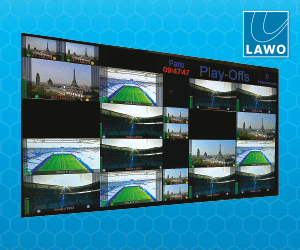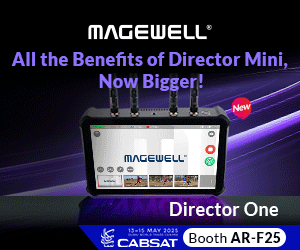The 48-hour film project saw aspiring filmmakers and industry professionals gather together on November 24 to celebrate the winning projects of this two-day endeavour. In the first part of this series, DoP and participant Harvey Glen gives us an exclusive first-person account of conceptualising, writing and making a film in just 48 hours The 48-hour […]
The 48-hour film project saw aspiring filmmakers and industry professionals gather together on November 24 to celebrate the winning projects of this two-day endeavour. In the first part of this series, DoP and participant Harvey Glen gives us an exclusive first-person account of conceptualising, writing and making a film in just 48 hours

The 48-hour film festival has been running for 10 years. Last year, 45,000 filmmakers had made 3,000 films in 80 cities on five continents in just 48 hours. This was the first year the festival was brought to Dubai.
The premise was simple you have 48 hours to write, shoot, produce, edit, score and deliver a short film that has to be 4-7 minutes, plus you are allowed one minute of credits at the end. All over the globe, it takes place over different weekends. You have to pick a team leader who goes and collects the information at 7pm (on Thursday, in Dubais case) and the delivery of the film can be no later than 7pm, 48 hours later.
I first heard about the project from a friend on Tuesday afternoon. Having had great success with the first ever user generated film Ridley Scott produced titled Life in a Day in which I participated with a story about an Indian expatriate gardener living and working in Dubai, I thought this was an opportunity I simply shouldnt miss. For Ridley Scotts production, my submission was selected from more than 80,000 entries and I was one of the 25 filmmakers and contributors chosen to go to the world famous Sundance Film Festival.
Professionally, I work as a cinematographer but to bring the 48-hour film project to fruition with only a 24-hour lead up, I needed to put my producers hat on. With the 48-hour film project, there is no budget so everyone who participates has to be a volunteer. I began by making calls to gather some crew and cast.
I knew that I was going to shoot this film so I had the DOP in place, plus I was mainly going to use my own personal equipment the Canon 5D MKII with 24-70mm and 70-200mm F2.8 lenses.
Then I called director Nizar Sfair, whom I have loved working with and have successfully collaborated with previously to shoot some beautiful commercials and promos.
Nizar had previously heard about the project and was keen to be part of it, so that was the director ticked off. The next step was to scout for cast.
The challenge here was that you could not pin down your cast until you received your criteria from the organisers at 7pm. By this time, your 48 hours have started and you have no idea of what your genre is, let alone your script.
I got in touch with Miranda Davidson who owns Miranda Davidson Studios, an acting coaching facility. Miranda invited Nizar and me down to her class that evening to watch some of her students perform. I also got in touch with Bareface, which kindly got in touch with the actors on their books and put together a selection of people who might be interested to take part.
So we had some actors on standby! Worse case scenario, we could actually make a film now, even if we had to shoot in my living room, which we actually did in the end.
Three important elements were now out of the way. I next contacted a photographer friend of mine Michael J Mckelvie, who expressed interest in learning how to shoot video and the whole process of making a film. He came on board as second camera operator, location scout and later turned out to be the interviewer and voice-over artist.
The only thing you can do before the 48 hours is scout your locations, set cast in place and prep your kit. Michael J McKelvie told Nizar and I about a location called Desert Springs. The location was perfect to set any story. Luckily, my friend and DIT Andrew Clemson knew a friend who lived there so we managed to secure permission to shoot there. Nizar and I had already arranged a steak dinner with Imad, GM from Optix Digital Post. We were fully prepared to cut the film on my Final Cut suite, but after casually mentioning the project, Imad said hed ask the team if we could use the Optix facilities over the weekend. SWEET! Neda Ahmed came onboard as post producer, An Nguyen as editor and Diane Kuo as colourist.
I was shooting that Thursday and was slightly concerned that we didnt have a sound recordist. Taking on the role of sound recordist along with producer and cinematographer was irrational as sound is crucial and often overlooked in production.
I often say if your picture goes slightly soft or over exposed for a second, the audience will rarely notice but if your audio is bad, they will notice. Great sound makes good picture great!
Luckily, on Thursday morning I bumped into sound recordist David Thirion who agreed to join the team.
Nizar was appointed as team leader and arrived at the Pavilion at 7pm to receive the criteria for the film.
We were told we had to use a prop, which was a clock (any clock), a line of dialogue you cant leave without making a decision, a character trait human encylopaedia and had to pull a genre out of the hat Nizar received Mockumentary.
Our team, named The Turtles arranged to meet at Optix at 8pm to start brainstorming. Nizar contacted Micheal Fillon, someone we both respected and worked with on a Pepsi job. Micheal has a unique creative perspective and without knowing anything about the project, Nizar managed to persuade him to come onboard and write the script.
While the rest of us went home to bed Micheal and Nizar stayed up through the night to develop the story about Karim Mushtak, played by Assem Kroma.
Karim is a novelist who had a best-selling novel. 10 years on, he is the last remaining tenant in Paradise Falls, where he refuses to leave until completing his long-anticipated second novel The Time Travelers Diary.
With an idea of the plot, Mike McKelvie and I met at 6am to start shooting some establishing shots of the location in the beautiful early morning light.
We then regrouped at 8.30pm with makeup artist Marcia Santos, Miranda Davidson, lead actor Assem Kroma and love interest Jenny played by May El Calamawy to go through the script which was literally hot off the press.
One of our biggest hurdles was printing out the script such a simple task, but not one of us had a printer.
However, as I like to say, every problem is a solution opportunity.
We didnt actually start shooting until around 1pm on the Friday, so with around only 30 hours left to completely finish our film, I knew we had to start production. Having donned the role of producer and with my eye on the clock, I felt it was my responsibility to push the production through and start shooting.
I always find that shooting the first shot is always the hardest thing. As soon as that is under way, any production can move forward.
I had decided right from the start that regardless of the genre we received, I would take a dogma style, literally because I didnt have time to ask any hire companies or technical crew for big favours. Having shot so many different types of programming (including 1x Promax winner, 2x Bafta, 1x Emmy), I know you can get great results and something aesthetically pleasing without all of the equipment we normally use on commercials. In fact, we didnt even have a follow focus, or monitor. Having such a great bond with Nizar, he trusted me to take care of the visuals while he directed the talent.
Actor Aseem Kroma fit into Karims role with ease. It was fantastic to watch him perform alongside JW Halloway, our human encylopaedia. It really did feel like a true documentary, almost in the vein of Louis Theroux.
With short films or any unpaid work, people are there for the passion of making something special and I feel our team The Turtles did that. We had such an amazing bunch of very talented people both on and off the screen. We still cannot believe Ray Haddad managed to score the entire film in less than eight hours.
Making a film in 48 hours restricts you heavily. I would have like to use all of the actors that were interested in taking part, but there just wasnt time. The worst part of being a producer is having to settle for some personalities on the set, letting down actors you had hoped to use and continually answering the phone. I now realise why camera work is so much more appealing. You can just get deep in the zone and concentrate on delivering beautiful and creative visuals.
During the shooting, we sent back batches of rushes where our post production team was ready to convert the files, digitise and start the rough cut over night. By 5.30pm the next day, the film was beginning to take shape, but we still needed to grade and export it and get it to the Pavilion in time to deliver it, all before 7pm. Luckily, I received an email saying we would get an additional half hour because of traffic so 7.30pm was acceptable but no later. We were literally burning DVDs in the car on the way. We arrived at 7.27pm and handed it in phew! It wasnt without its faults but for a film produced in 48 hours, it was a huge success.
We won several awards that night but we did not win Best Film. It was announced at the awards that Paradise Falls would have won Best Film if we hadnt got the human encyclopaedias name wrong, which was part of the mandate in the beginning.
But the sheer passion of making this film will bring all of us together again next year.
Watch a short exclusive video footage of the 48-hour film project awards night on www.broadcastprome.com, brought to you by BroadcastPro Middle East.
















































































